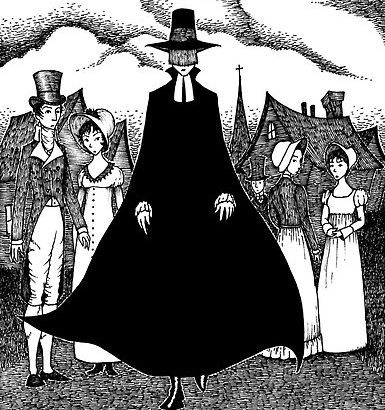
- Posted: 18 octubre, 2016
- By: Instituto Internacional
- Comments: No Comments
ENGLISH READING CIRCLE – SHORT STORY OF THE MONTH ANALYSIS: “THE MINISTER’S BLACK VEIL” BY NATHANIEL HAWTHORNE
This month’s story, Nathaniel Hawthorne’s “The Minister’s Black Veil,” was first published in 1832, then republished in 1837 in Twice-Told Tales, a collection of the author’s short stories. In his review of this collection, Edgar Allen Poe referred to Hawthorne, who was not widely celebrated at the time, as a writer of “extraordinary genius.” Given the gloom that the two stories so far read in our circle share, Poe’s praise should perhaps not be surprising. And time has, after all, proven him correct; Hawthorne’s place in the American canon is now assured. His work, unlike that of many of his contemporaries, retains its resonance almost two hundred years later.
“The Minister’s Black Veil” is a strange story insofar as it enacts in literary form that which it describes. The motive and explanation behind Parson Hooper’s black veil are as much a mystery for the reader as they are for the townspeople disturbed by it daily. Hooper never provides a rationale for his decision to shroud his face from all eyes, including his own. The closest we get to such an explanation is his deathbed elaboration on the lesson it contains, if we (readers and townspeople alike) are willing to undergo the self-examination necessary to recognize our own, figurative veils which we “wear” to hide our most secret sins from those we claim to be our intimate friends, family, and lovers. But this, again, is not a cause; it is an intended effect, put forward by a man expected to set an example of moral righteousness for his flock to follow. In the story it seems as if Hooper’s eccentricity does achieve this desired effect, if only partially. His sermons become more and more powerful thanks to the constant presence of the veil, there to serve as grim reminder of the truth of Hooper’s words. The veil is proof of the sin that resides in all human hearts. But while his sermons grow in power, his place within the community shrinks, as he is regarded with curiosity in the best of cases, and outright fear and suspicion in the worst.
One important question to ask here is: should we consider Parson Hooper the hero or the villain of the story? This is perhaps too simplistic a line of interpretation, but it takes us onto important and worthy analytical ground. Does Hooper’s decision to wear the veil carry with it impure sinful consequences for he himself? Does it represent an act of saintly self-abnegation, or is it instead proof of a deeper flaw, such as pride? Going beyond the question of individual motive and psychology, it is important to recognize and refine the larger statement Hawthorne is making about Puritan New England. Why does the veil produce such discomfort among the townspeople? Is that discomfort something universal to any human, from any time or place? Or is it instead something that is to a great degree particular to this context? These are all questions I would like to address in our meeting, in addition to those you bring with you. Until then, happy reading, and see you next Tuesday.
See you at the colloquium next Tuesday,
Andrew
Search
Categorías
Noticias recientes
-
Becas parciales Ruth Lee Kennedy – Abierta la convocatoria 2025-2026
18 noviembre, 2024 -

Introducing Library League: A Monthly Program for Readers of All Ages By Hilary Misle
12 noviembre, 2024 -

Halloween Concert: The Louisiana Cats. An Interview with D.D. Dunn
4 octubre, 2024
